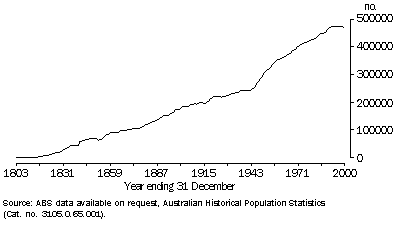Feature Article - History of Tasmania's population 1803-2000
The first human inhabitants of what is now Tasmania arrived more than 35,000 years ago, crossing the land bridge that then connected Tasmania to the Australian mainland. The total population, before white settlement, has been estimated at between 5,000 and 10,000.
White settlement began in 1803 to secure British strategic interests against the French. In keeping with the penal nature of the early settlement, most of the population were convicts or government officials. At the Census of 1847, just over 50% of the total population of 70,000 were, or had been, convicts. Less than 20% were free immigrants.
Until the mid-nineteenth century, Tasmania experienced a fairly rapid build-up of population. However, in the early 1850s this rapid rate of population increase slumped. This decline was due to two major factors: the discovery of gold in Victoria in 1851, which led to a large-scale emigration of Tasmanians, and the ending of transportation of convicts in 1853. This decline was reversed in the early 1870s, partly due to a growth in markets for Tasmanian primary products, and also important tin and gold discoveries in Tasmania. Between 1861 and 1876, the population increased from 90,000 to 105,000. The next 15 years to 1891 saw the population reach 151,150, an annual rate of increase more than double that of the previous period.
The effects of economic depression in Australia in the 1890s, while severe, were eased somewhat in Tasmania by the silver and copper mining boom on the West Coast. Tasmania’s relative prosperity was reflected in a net migration in excess of 4,000 per year from 1896 to 1899. While federation in 1901 meant free access to Australian mainland markets for primary producers, many small manufacturers faced strong competition from Australian mainland firms.
Economic stagnation, exacerbated by the decline of the West Coast mining boom, was reflected in a drift of people to the mainland. Attracting manufacturing industries through the provision of cheap hydro-electric power came to be seen as a way out of the economic gloom. While this was partly successful, it was not wholly sufficient, especially during the economic depression of the late 1920s and 1930s. Rural industries, always important to Tasmania’s economic well-being, were particularly affected by the depression. In the 35 years between 1900 and 1935, Tasmania’s population grew at less than 0.7% per year.
After World War II, Tasmania shared in the prosperity of the Australian economy. The post-war baby boom and gains from overseas immigration resulted in an annual population increase of 1.5% in the 35 years from 1945 to 1980, more than double the pre-war rate. Tasmanians made up 2.9% of the total Australian population at 30 June 1976.
In the 1980s, Tasmania's population still lagged behind the Australian mainland States. Tasmania’s annual growth rate averaged 0.8% while the Australian growth rate averaged 1.5%. As a result, the proportion of the total Australian population living in Tasmania decreased to 2.7% at 30 June 1989.
In the 1990s, while the Australian growth rate averaged 1.2% in the first eight years, Tasmania averaged only 0.5%. With the annual rate below 0.5% since the beginning of 1993, Tasmania’s proportion of the total Australian population at 30 June 2000 decreased to 2.5%.
POPULATION, Tasmania - 1803-2000

 Print Page
Print Page
 Print All
Print All